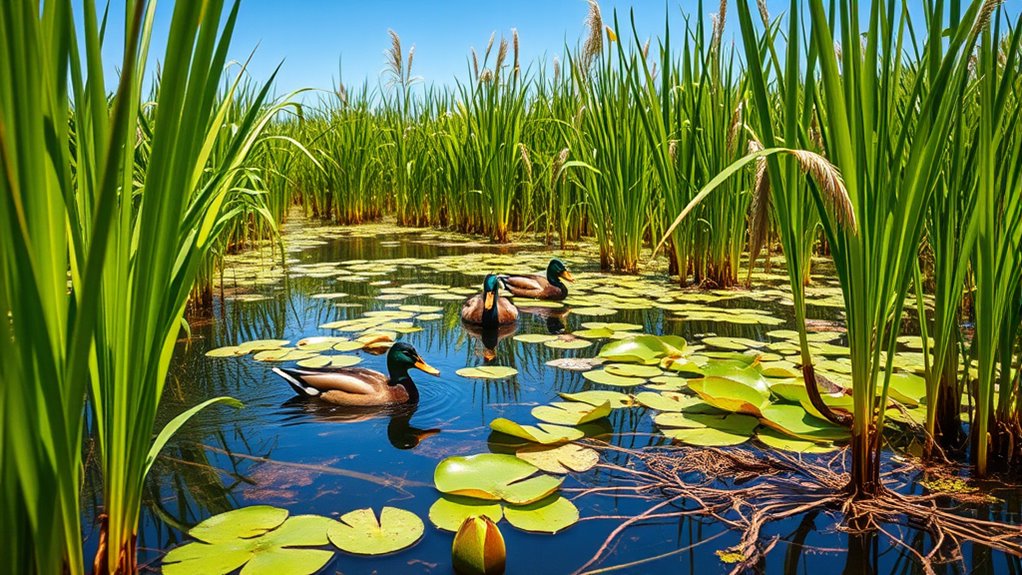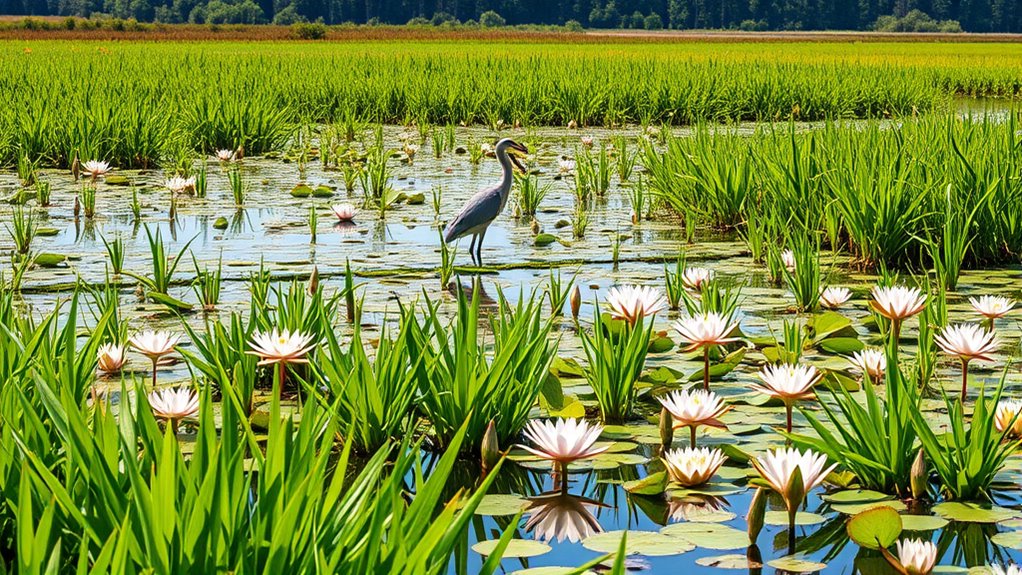Ecosystem services are the essential benefits nature provides that support your health, economy, and community resilience. These include clean air and water, climate regulation, food, and protection from storms. Recognizing their value helps you understand why conserving marine biodiversity and green spaces is vital for maintaining these benefits. By supporting conservation efforts, you’ll help guarantee a sustainable future. To learn more about how nature’s value impacts you directly, keep exploring the connections between ecosystems and our well-being.
Key Takeaways
- Ecosystem services are the benefits humans receive from natural environments, including provisioning, regulating, supporting, and cultural functions.
- Valuing nature highlights the economic and social importance of conserving ecosystems to ensure their sustainability.
- Quantifying ecosystem services helps inform policy decisions and promotes investments in environmental preservation.
- Recognizing ecosystem value encourages responsible behavior and supports conservation efforts to maintain biodiversity.
- Protecting ecosystems ensures the resilience of climate regulation, food supply, water quality, and disaster risk reduction.

Have you ever wondered how natural environments support your daily life? When you think about the world around you, it’s easy to overlook the essential roles that ecosystems play. One key aspect is marine biodiversity, which refers to the variety of life found in our oceans. This biodiversity isn’t just about colorful fish or coral reefs; it’s indispensable for regulating climate, supporting fishing industries, and maintaining healthy coastal areas. Marine ecosystems act as natural buffers against storms and erosion, providing protection that saves countless lives and properties. Without rich marine biodiversity, these benefits diminish, leading to increased vulnerability and economic costs. Protecting these underwater habitats ensures that they continue to deliver these crucial services, benefiting everyone, including you. Ecosystem health is vital for maintaining these services and ensuring resilience against environmental threats.
Rich marine biodiversity protects coasts, supports livelihoods, and combats climate change—vital for a resilient, sustainable future for all.
Closer to home, urban green spaces—parks, gardens, and tree-lined streets—are another essential component of ecosystem services. These areas do more than offer a pleasant escape from city life; they improve air quality by filtering pollutants and producing oxygen. Green spaces also help regulate temperature, reducing the urban heat island effect and making cities more livable during hot weather. When you spend time in a park or walk through a tree-shaded street, you’re experiencing the tangible benefits of ecosystem services in action. These spaces also support urban biodiversity by providing habitats for birds, insects, and small mammals, maintaining ecological balance amid concrete jungles. Furthermore, urban green spaces promote mental health and physical activity, making them indispensable for your well-being.
Ecosystem services like marine biodiversity and urban green spaces are interconnected, forming a web of benefits that sustain life in both natural and human-made environments. They help filter water, control flooding, and provide raw materials such as food and medicinal plants. When natural environments thrive, they offer a resilient foundation that supports economic stability and social well-being. Yet, many of these services are under threat from pollution, habitat destruction, and climate change. Recognizing their value means understanding that conserving marine biodiversity and expanding urban green spaces isn’t just an act of environmental stewardship; it’s an investment in your future.
You play a pivotal role in this process, whether it’s by supporting conservation efforts, reducing pollution, or advocating for greener urban planning. Every small action contributes to maintaining these ecosystem services, guaranteeing they continue to support your daily life. When you appreciate the importance of these natural assets, you become a part of a larger movement to protect and sustain the environment for generations to come. Remember, the health of ecosystems directly impacts your quality of life—so safeguarding marine biodiversity and expanding urban green spaces benefits us all, now and in the future.
Frequently Asked Questions
How Are Ecosystem Services Quantified Financially?
You quantify ecosystem services financially through ecosystem valuation, which assigns monetary metrics to benefits provided by nature. By using methods like contingent valuation, cost-benefit analysis, or replacement cost, you can estimate these benefits in dollar terms. This process helps you understand the economic value of ecosystems, making it easier to incorporate their importance into decision-making and policy, ultimately highlighting their critical role in human well-being and sustainability.
What Policies Support Ecosystem Service Preservation?
You can support ecosystem service preservation through policies like payment schemes and conservation policies. Payment schemes, such as payments for ecosystem services (PES), incentivize landowners to protect natural resources. Conservation policies establish protected areas and enforce sustainable practices. These policies motivate responsible stewardship, ensuring ecosystems continue providing essential services. By advocating for these policies, you help safeguard biodiversity, improve water quality, and maintain climate stability for future generations.
How Do Climate Change Impacts Affect Ecosystem Services?
Climate change causes chaos, compromising ecosystem services vital for your well-being. Rising temperatures and unpredictable weather weaken ecosystem resilience, making natural systems less able to adapt. This diminishes resources like clean water, fertile soil, and air quality, directly impacting your life. To protect these services, prioritize climate adaptation strategies that bolster ecosystem resilience, ensuring nature can withstand and recover from climate shocks, securing your future and the environment’s health.
Who Are the Main Stakeholders Involved?
You’re involved with various stakeholders like Indigenous communities practicing stewardship and corporations taking responsibility for environmental impacts. Governments, NGOs, and local residents also play key roles. Indigenous stewardship guarantees sustainable use, while corporate responsibility focuses on minimizing harm. By engaging these stakeholders, you help protect ecosystem services, ensuring nature’s benefits continue for future generations. Your active participation fosters collaboration and promotes policies that balance economic growth with environmental health.
How Can Individuals Contribute to Ecosystem Service Protection?
You can contribute to ecosystem service protection by engaging with your community and promoting sustainable practices. Participate in local conservation initiatives, support eco-friendly businesses, and advocate for policies that protect natural resources. Education and awareness are key, so share knowledge about ecosystem benefits and the importance of preserving nature. Your active involvement helps foster a collective effort, ensuring ecosystems continue to provide essential services for future generations.
Conclusion
Think of nature as a treasure chest, brimming with invaluable gifts that sustain us all. By valuing ecosystem services, you reveal the true worth of this living bank—each tree, river, and pollinator symbolizing hope and balance. When you protect and cherish these natural treasures, you’re safeguarding your future and the planet’s. Remember, the health of the ecosystem is the mirror reflecting your own well-being—treat it with care, and it will continue to nourish you.










